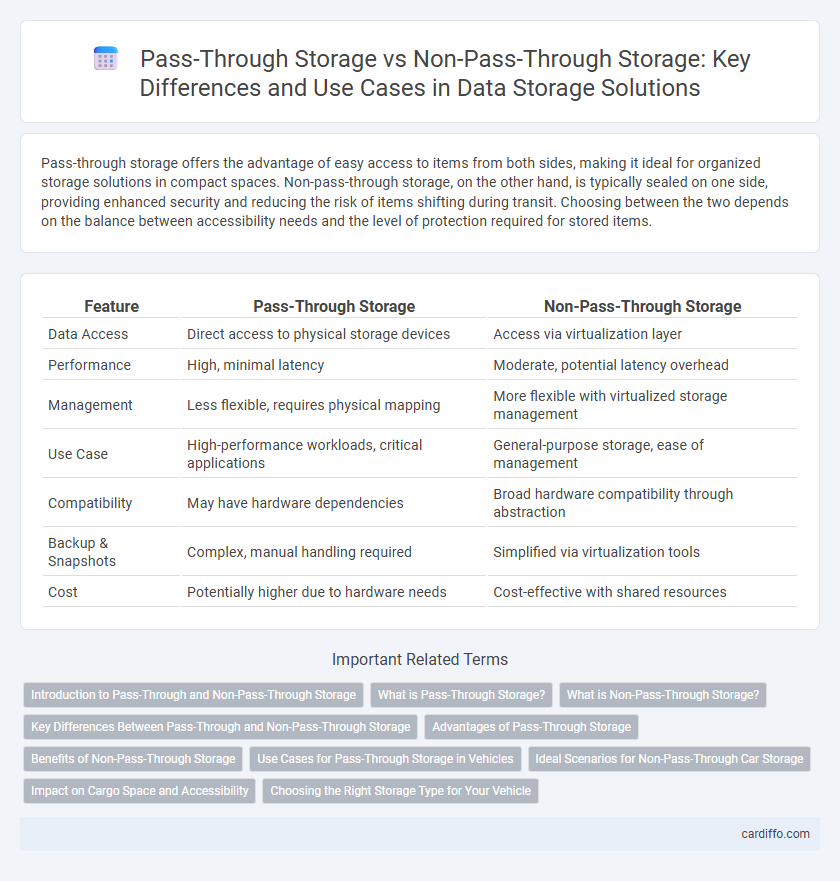Pass-through storage offers the advantage of easy access to items from both sides, making it ideal for organized storage solutions in compact spaces. Non-pass-through storage, on the other hand, is typically sealed on one side, providing enhanced security and reducing the risk of items shifting during transit. Choosing between the two depends on the balance between accessibility needs and the level of protection required for stored items.
Table of Comparison
| Feature | Pass-Through Storage | Non-Pass-Through Storage |
|---|---|---|
| Data Access | Direct access to physical storage devices | Access via virtualization layer |
| Performance | High, minimal latency | Moderate, potential latency overhead |
| Management | Less flexible, requires physical mapping | More flexible with virtualized storage management |
| Use Case | High-performance workloads, critical applications | General-purpose storage, ease of management |
| Compatibility | May have hardware dependencies | Broad hardware compatibility through abstraction |
| Backup & Snapshots | Complex, manual handling required | Simplified via virtualization tools |
| Cost | Potentially higher due to hardware needs | Cost-effective with shared resources |
Introduction to Pass-Through and Non-Pass-Through Storage
Pass-through storage enables direct access to physical storage devices by virtual machines, enhancing performance by minimizing overhead and latency. Non-pass-through storage involves virtualized storage where data passes through a host system or intermediary layers, allowing greater flexibility and advanced management features like snapshots and backups. Choosing between them depends on requirements for speed, scalability, and ease of management in storage architectures.
What is Pass-Through Storage?
Pass-through storage is a method where storage devices are directly mapped to a virtual machine, bypassing the host's file system to provide near-native performance and lower latency. It allows virtual machines to access physical storage hardware, such as SSDs or HDDs, directly, which enhances I/O throughput and reduces overhead. This approach contrasts with non-pass-through storage, where the host manages storage via software-based abstraction layers, potentially impacting speed and efficiency.
What is Non-Pass-Through Storage?
Non-pass-through storage refers to a virtualized storage setup where the hypervisor or storage controller intermediates all data traffic between the virtual machine and the physical storage device, rather than granting direct access. This method enhances data management features such as snapshots, replication, and encryption by allowing the hypervisor to control and monitor storage interactions. Non-pass-through storage is commonly used in environments requiring advanced data protection and centralized storage management.
Key Differences Between Pass-Through and Non-Pass-Through Storage
Pass-through storage allows direct access to physical storage devices by virtualization hosts, enhancing performance and reducing latency by bypassing the hypervisor layer. Non-pass-through storage involves abstracted access where the hypervisor manages storage resources, providing features like snapshots, cloning, and easier management at the cost of additional overhead. Key differences include control granularity, performance impact, and flexibility, with pass-through ideal for high-performance workloads and non-pass-through suited for environments requiring advanced storage services.
Advantages of Pass-Through Storage
Pass-through storage offers enhanced performance by allowing direct access to physical storage devices, minimizing latency and improving input/output efficiency. It provides greater flexibility in managing storage resources, enabling virtualization environments to allocate specific disks directly to virtual machines for better isolation and security. This method also simplifies troubleshooting and reduces overhead compared to non-pass-through storage, where data path abstraction can introduce delays and complexity.
Benefits of Non-Pass-Through Storage
Non-pass-through storage enhances data security by isolating the storage environment from direct access, reducing the risk of data corruption or unauthorized modification. It offers greater control over data management and supports advanced features like snapshotting and granular backups, ensuring better data integrity. This storage type also improves system stability by preventing storage device failures from directly impacting the host system.
Use Cases for Pass-Through Storage in Vehicles
Pass-through storage in vehicles allows cargo to extend from the trunk directly into the cabin, maximizing space efficiency for transporting long items such as skis, lumber, or fishing rods. This design is ideal for outdoor enthusiasts and tradespeople who require easy access and secure transport of oversized gear without sacrificing passenger comfort. Vehicles equipped with pass-through storage feature enhanced versatility, supporting both daily commuting and specialized hauling needs.
Ideal Scenarios for Non-Pass-Through Car Storage
Non-pass-through storage is ideal for preserving sensitive items or valuable vehicles where controlled access and security are paramount, such as in luxury car storage facilities or private garages. This method prevents unauthorized access through compartmentalization, ensuring that stored vehicles remain protected from theft or environmental damage. It also suits long-term storage scenarios where maintaining specific climate conditions inside individual compartments prolongs the car's lifespan and maintains its value.
Impact on Cargo Space and Accessibility
Pass-through storage significantly enhances cargo space by allowing items to be stored across compartments, creating a larger continuous area for bulky or elongated objects. Non-pass-through storage confines items to individual, separate compartments, limiting the ability to store larger or irregularly shaped cargo efficiently. Access to pass-through storage is typically more convenient, facilitating easy loading and unloading from multiple points, whereas non-pass-through storage often restricts accessibility to fixed openings, reducing flexibility in cargo management.
Choosing the Right Storage Type for Your Vehicle
Pass-through storage offers direct access from the driver's cabin to the cargo area, enhancing convenience for transporting tools or equipment without exiting the vehicle. Non-pass-through storage provides secure, compartmentalized spaces outside the cabin, ideal for separating personal items from work gear and protecting valuables. Selecting the right storage type depends on your vehicle use, balancing ease of access with security and organization needs to optimize functionality.
pass-through storage vs non-pass-through storage Infographic

 cardiffo.com
cardiffo.com